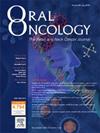Post-treatment monitoring of surgically treated oropharyngeal squamous cell carcinoma patients using human papillomavirus cell-free DNA
IF 4
2区 医学
Q1 DENTISTRY, ORAL SURGERY & MEDICINE
引用次数: 0
Abstract
Introduction
The incidence rate of human papillomavirus (HPV)-driven oropharyngeal squamous cell carcinoma (OPSCC) is increasing. Despite good prognosis, recurrence can decrease health-related quality of life and increase mortality, so post-treatment monitoring is important for patient outcomes. One potential biomarker for post-treatment monitoring is HPV cell-free DNA (cfDNA) from blood plasma.
Methods
Plasma samples at start of treatment and during follow-up from 27 OPSCC patients were analyzed for cfDNA of six high-risk HPV types using a multiplex digital PCR assay. Presence of HPV cfDNA was compared to HPV tumor status determined by p16INK4a immunohistochemistry, HPV DNA, HPV RNA and HPV16 E6 serology.
Results
At start of treatment, sensitivity of HPV cfDNA detection in HPV-driven OPSCC cases was 89 % (17/19), while specificity was 100 % among 39 plasma samples from 8 HPV-negative OPSCC cases. A median of 4 follow-up plasma samples per patient over a mean time of 11 months were available. Positive and negative predictive values during follow-up were assessed on a per-test-basis. HPV cfDNA testing after completion of therapy had a positive predictive value of 100 % for HPV-OPSCC recurrence within one year, and a negative predictive value of 98 %. In cases of recurrent HPV-driven OPSCC, HPV cfDNA was detectable between 3 and 6.8 months before detection of recurrence by routine follow-up examination methods.
Conclusion
Post-treatment monitoring for early detection of recurrence could be aided by testing for HPV cfDNA in HPV-driven OPSCC patients.
应用人乳头瘤病毒无细胞DNA对口咽鳞状细胞癌术后患者的监测
摘要人乳头瘤病毒(HPV)驱动的口咽鳞状细胞癌(OPSCC)的发病率呈上升趋势。尽管预后良好,但复发会降低与健康相关的生活质量并增加死亡率,因此治疗后监测对患者预后很重要。治疗后监测的一个潜在生物标志物是来自血浆的HPV无细胞DNA (cfDNA)。方法对27例OPSCC患者在治疗开始和随访期间的血浆样本进行多重数字PCR检测,检测6种高危型HPV的cfDNA。将HPV cfDNA的存在与p16INK4a免疫组化、HPV DNA、HPV RNA和hpv16e6血清学检测的HPV肿瘤状态进行比较。结果在治疗开始时,HPV驱动的OPSCC患者中,HPV cfDNA检测的敏感性为89%(17/19),而在8例HPV阴性的OPSCC患者的39份血浆样本中,特异性为100%。在平均11个月的时间内,每位患者中位获得4份随访血浆样本。随访期间的阳性和阴性预测值以每次测试为基础进行评估。治疗完成后进行HPV cfDNA检测,一年内HPV- opscc复发的阳性预测值为100%,阴性预测值为98%。在HPV驱动的复发性OPSCC中,在常规随访检查方法发现复发前3至6.8个月可检测到HPV cfDNA。结论对HPV驱动的OPSCC患者进行HPV cfDNA检测有助于治疗后监测早期复发。
本文章由计算机程序翻译,如有差异,请以英文原文为准。
求助全文
约1分钟内获得全文
求助全文
来源期刊

Oral oncology
医学-牙科与口腔外科
CiteScore
8.70
自引率
10.40%
发文量
505
审稿时长
20 days
期刊介绍:
Oral Oncology is an international interdisciplinary journal which publishes high quality original research, clinical trials and review articles, editorials, and commentaries relating to the etiopathogenesis, epidemiology, prevention, clinical features, diagnosis, treatment and management of patients with neoplasms in the head and neck.
Oral Oncology is of interest to head and neck surgeons, radiation and medical oncologists, maxillo-facial surgeons, oto-rhino-laryngologists, plastic surgeons, pathologists, scientists, oral medical specialists, special care dentists, dental care professionals, general dental practitioners, public health physicians, palliative care physicians, nurses, radiologists, radiographers, dieticians, occupational therapists, speech and language therapists, nutritionists, clinical and health psychologists and counselors, professionals in end of life care, as well as others interested in these fields.
 求助内容:
求助内容: 应助结果提醒方式:
应助结果提醒方式:


